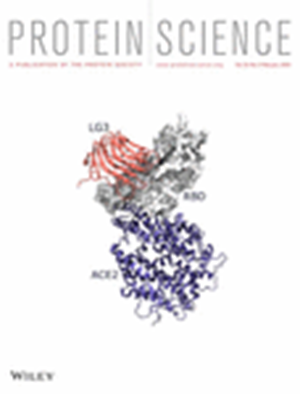人类 Sirtuin 2 二聚体形成的生物物理启示
IF 4.5
3区 生物学
Q1 BIOCHEMISTRY & MOLECULAR BIOLOGY
引用次数: 0
摘要
Sirtuin 2(SIRT2)是第三类组蛋白去乙酰化酶,从细菌到哺乳动物都高度保守。我们利用各种生物物理方法制备并鉴定了人 SIRT2(hSIRT2)组蛋白去乙酰化酶(HDAC)结构域的野生型(WT)和突变型形式,并评估了它们的去乙酰化活性。我们发现,WT hSIRT2 HDAC(残基 52-357)以浓度依赖的方式形成同源二聚体,二聚体与单体的解离常数为 8.3 ± 0.5 μM,这是由质谱测定的。通过与 HDAC 抑制剂 SirReal1 和 SirReal2 结合,二聚体被分解为两个单体。我们还利用 NanoLuc 互补报告系统证实了 hSIRT2 HDAC 在活细胞中形成的二聚体。利用 hSIRT2 HDAC 的几种突变体研究二聚体形成与去乙酰化活性之间的关系发现,一些非二聚化突变体对组蛋白 H3 的 N 端肽具有去乙酰化活性,与野生型相似。hSIRT2 HDAC突变体Δ292-306缺乏SIRT2特异性无序环区,经鉴定它以单体形式存在,去乙酰化活性略有降低;突变体Δ292-306的X射线结构与WT hSIRT2 HDAC与抑制剂结合的结构几乎相同。这些结果表明,hSIRT2 HDAC 形成了二聚体,但这与去乙酰化活性无关。在此,我们将根据生物物理实验结果讨论对 hSIRT2 形成二聚体的见解。本文章由计算机程序翻译,如有差异,请以英文原文为准。
Biophysical insights into the dimer formation of human Sirtuin 2
Sirtuin 2 (SIRT2) is a class III histone deacetylase that is highly conserved from bacteria to mammals. We prepared and characterized the wild‐type (WT) and mutant forms of the histone deacetylase (HDAC) domain of human SIRT2 (h SIRT2) using various biophysical methods and evaluated their deacetylation activity. We found that WT h SIRT2 HDAC (residues 52–357) forms a homodimer in a concentration‐dependent manner with a dimer–monomer dissociation constant of 8.3 ± 0.5 μM, which was determined by mass spectrometry. The dimer was disrupted into two monomers by binding to the HDAC inhibitors SirReal1 and SirReal2. We also confirmed dimer formation of h SIRT2 HDAC in living cells using a NanoLuc complementation reporter system. Examination of the relationship between dimer formation and deacetylation activity using several mutants of h SIRT2 HDAC revealed that some non‐dimerizing mutants exhibited deacetylation activity for the N‐terminal peptide of histone H3, similar to the wild type. The h SIRT2 HDAC mutant Δ 292–306, which lacks a SIRT2‐specific disordered loop region, was identified to exist as a monomer with slightly reduced deacetylation activity; the X‐ray structure of the mutant Δ 292–306 was almost identical to that of the WT h SIRT2 HDAC bound to an inhibitor. These results indicate that h SIRT2 HDAC forms a dimer, but this is independent of deacetylation activity. Herein, we discuss insights into the dimer formation of h SIRT2 based on our biophysical experimental results.
求助全文
通过发布文献求助,成功后即可免费获取论文全文。
去求助
来源期刊

Protein Science
生物-生化与分子生物学
CiteScore
12.40
自引率
1.20%
发文量
246
审稿时长
1 months
期刊介绍:
Protein Science, the flagship journal of The Protein Society, is a publication that focuses on advancing fundamental knowledge in the field of protein molecules. The journal welcomes original reports and review articles that contribute to our understanding of protein function, structure, folding, design, and evolution.
Additionally, Protein Science encourages papers that explore the applications of protein science in various areas such as therapeutics, protein-based biomaterials, bionanotechnology, synthetic biology, and bioelectronics.
The journal accepts manuscript submissions in any suitable format for review, with the requirement of converting the manuscript to journal-style format only upon acceptance for publication.
Protein Science is indexed and abstracted in numerous databases, including the Agricultural & Environmental Science Database (ProQuest), Biological Science Database (ProQuest), CAS: Chemical Abstracts Service (ACS), Embase (Elsevier), Health & Medical Collection (ProQuest), Health Research Premium Collection (ProQuest), Materials Science & Engineering Database (ProQuest), MEDLINE/PubMed (NLM), Natural Science Collection (ProQuest), and SciTech Premium Collection (ProQuest).
 求助内容:
求助内容: 应助结果提醒方式:
应助结果提醒方式:


